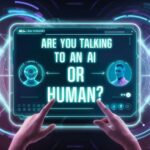In today’s rapidly evolving technological landscape, it’s becoming increasingly difficult to distinguish between interactions with artificial intelligence (AI) and those with human beings.
As AI continues to advance and become more sophisticated, the lines between human and machine communication are blurring.
This article explores the complexities of determining whether you are conversing with an AI or a human and the implications of this ambiguity.
The Rise of Conversational AI
The development of conversational AI has been a game-changer in the realm of human-computer interaction. These intelligent systems, powered by natural language processing (NLP) and machine learning algorithms, can engage in human-like conversations, understand context, and provide relevant responses.
From virtual assistants like Siri and Alexa to chatbots on websites and messaging platforms, conversational AI is becoming ubiquitous in our daily lives.
Advancements in Natural Language Processing
One of the key factors contributing to the difficulty in distinguishing between AI and human communication is the remarkable progress made in natural language processing.
NLP enables machines to understand, interpret, and generate human language, allowing for more natural and fluid conversations.
Some of the notable advancements in NLP include:
- Sentiment Analysis: AI systems can now analyze the sentiment behind words, detecting emotions and opinions expressed in text.
- Named Entity Recognition: NLP algorithms can identify and classify named entities, such as people, organizations, and locations, within a given text.
- Contextual Understanding: Advanced AI models can understand the context of a conversation, considering previous interactions and adapting responses accordingly.
These advancements have significantly enhanced the ability of AI to engage in human-like conversations, making it harder to discern whether you are interacting with a machine or a person.
The Turing Test and Its Limitations
The Turing Test, proposed by Alan Turing in 1950, is a well-known method for evaluating a machine’s ability to exhibit intelligent behavior indistinguishable from that of a human.
In the test, a human evaluator engages in a conversation with both a human and a machine, and if the evaluator cannot reliably tell them apart, the machine is said to have passed the test.
However, the Turing Test has its limitations:
- Narrow Domain: The test is often conducted within a specific domain or context, which may not reflect the full range of human conversation.
- Short Interactions: The test typically involves short interactions, which may not be sufficient to uncover the subtle differences between human and AI communication.
- Lack of Visual Cues: The test relies solely on text-based communication, neglecting the importance of visual cues and body language in human interaction.
Despite these limitations, the Turing Test remains a benchmark for assessing the human-likeness of AI systems, and many researchers continue to work on developing AI that can pass the test convincingly.
More Post:
Top Technology Companies in the USA in 2024
Distinguishing Between AI and Human Communication

While it can be challenging to differentiate between AI and human communication, there are certain aspects that can help you make an informed guess.
Consistency and Memory
One key difference between AI and human communication is consistency and memory. AI systems are designed to provide consistent responses based on their training data and algorithms.
They can recall previous interactions with precision and provide relevant information without the lapses in memory that humans may experience.
On the other hand, human communication is subject to variability and inconsistencies. Humans may forget details, provide slightly different responses to similar questions, or introduce new information based on their personal experiences and knowledge.
Emotional Intelligence and Empathy
Another factor to consider is emotional intelligence and empathy. While AI systems can be trained to recognize and respond to emotions to a certain extent, they may struggle with the nuances and depth of human emotions. AI responses may come across as formulaic or lacking in genuine empathy.
Humans, on the other hand, have the ability to understand and relate to emotions on a deeper level. They can provide personalized and empathetic responses, drawing from their own experiences and feelings.
Creativity and Originality
Creativity and originality can also be indicators of human communication. While AI systems can generate human-like responses, they are ultimately based on patterns and information derived from their training data. AI-generated content may lack the unique perspectives, opinions, and creative flair that humans bring to conversations.
Human communication often involves generating original ideas, thinking outside the box, and offering novel solutions to problems. The ability to combine seemingly unrelated concepts and come up with innovative insights is a hallmark of human creativity.
Implications and Ethical Considerations
The blurring of lines between AI and human communication raises important implications and ethical considerations.
Privacy and Data Protection
As conversational AI becomes more prevalent, concerns around privacy and data protection come to the forefront. When engaging with AI systems, users may inadvertently share personal information, assuming they are conversing with a human.
It is crucial for organizations deploying AI to be transparent about their use of these technologies and ensure appropriate data protection measures are in place.
Transparency and Disclosure
Transparency and disclosure are essential when it comes to AI-powered communication. Companies and developers have a responsibility to inform users when they are interacting with an AI system.
Clear labeling and disclaimers can help users make informed decisions about their interactions and manage their expectations accordingly.
Ethical AI Development
As AI continues to advance, it is crucial to prioritize ethical considerations in its development and deployment. This includes ensuring that AI systems are designed to be unbiased, transparent, and accountable.
Developers must strive to create AI that respects human values, promotes fairness, and avoids perpetuating harmful stereotypes or discrimination.
Read More:
How to Turn Off Meta AI: A Comprehensive Guide
FAQs
1. Can AI systems understand sarcasm and humor?
While AI has made significant strides in understanding language nuances, detecting sarcasm and humor remains a challenge. Sarcasm often relies on subtle cues, tone, and context, which can be difficult for AI to interpret accurately. Researchers are working on developing AI models that can better understand and generate sarcastic and humorous responses.
2. Are there any foolproof ways to determine if you are talking to an AI or a human?
Currently, there is no foolproof method to determine with absolute certainty whether you are communicating with an AI or a human. The lines between AI and human communication are becoming increasingly blurred as technology advances. Paying attention to factors such as consistency, emotional intelligence, and creativity can help you make an informed guess.
3. Can AI replace human customer service representatives?
While AI-powered chatbots and virtual assistants can handle routine customer inquiries and provide quick responses, they may not be able to fully replace human customer service representatives. Complex issues, emotional situations, and unique customer needs often require the empathy, problem-solving skills, and personalized approach that human representatives provide.
4. How can businesses balance the use of AI and human communication?
Businesses can strike a balance between AI and human communication by leveraging the strengths of both. AI can be utilized for handling repetitive tasks, providing instant responses, and managing high volumes of inquiries. Human representatives can focus on more complex issues, provide personalized support, and handle situations that require emotional intelligence and creative problem-solving.
5. What is the future of AI in communication?
The future of AI in communication looks promising, with continued advancements in natural language processing, machine learning, and emotional intelligence. We can expect AI systems to become even more sophisticated in understanding and generating human-like responses. However, it is essential to prioritize ethical considerations, transparency, and the preservation of human values as AI becomes more integrated into our communication channels.
Conclusion
Distinguishing between AI and human communication is becoming increasingly challenging as technology advances. The rise of conversational AI, powered by natural language processing and machine learning, has blurred the lines between human and machine interaction. While factors such as consistency, emotional intelligence, and creativity can provide clues, there is no foolproof method to determine with certainty whether you are conversing with an AI or a human.
As we navigate this new reality, it is crucial to prioritize transparency, ethical considerations, and the responsible development and deployment of AI systems.
By striking a balance between AI and human communication, businesses can leverage the strengths of both to provide efficient and personalized experiences for their customers.
As individuals, it is essential to be aware of the presence of AI in our daily interactions and to approach these conversations with a critical eye. While AI has the potential to revolutionize communication and make our lives more convenient, it is important to remember the value of human connection, empathy, and creativity in our interactions with one another.







